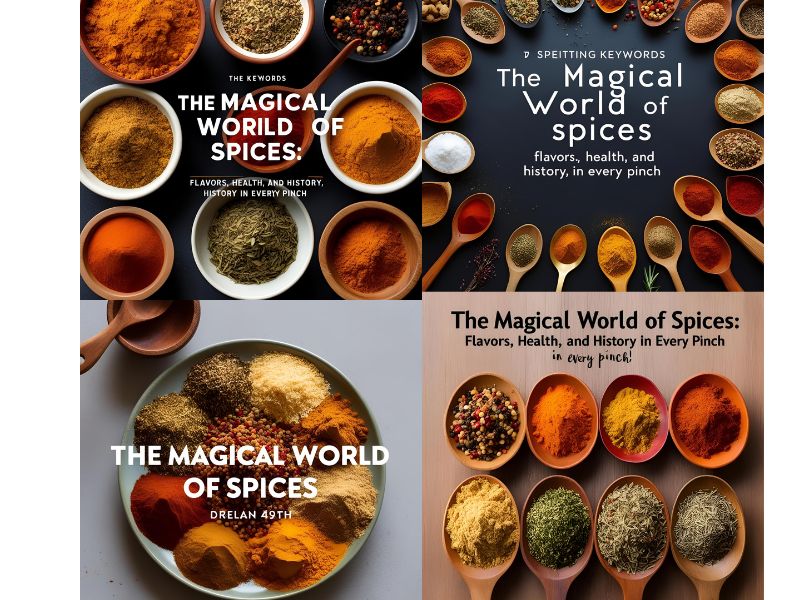Spices are more than just kitchen essentials—they are the soul of culinary art, bursting with flavor, color, and aroma. From ancient trade routes to your modern kitchen, spices have traveled through time, transforming ordinary dishes into extraordinary experiences.
In this blog, let’s dive into the colorful, aromatic, and fascinating world of spices. Whether you’re a seasoned chef, a health enthusiast, or someone who loves to explore flavors, this guide will spice up your knowledge.
What Are Spices?
Spices are dried parts of plants—such as seeds, bark, roots, and fruits—used to enhance the flavor, aroma, and color of food. Unlike herbs (which are usually the leafy parts of plants), spices often have more intense flavors and aromas.

The Fascinating History of Spices
Did you know spices were once worth more than gold?
- Ancient Civilizations: Egyptians used spices like cinnamon and cumin in embalming.
- Spice Routes: Traders from India, China, and the Middle East established legendary spice routes.
- Age of Exploration: Spices drove explorers like Vasco da Gama and Christopher Columbus to sail uncharted seas.
- Currency of Power: Spices like black pepper were used as currency and to showcase wealth.
Top 10 Must-Have Spices in Every Kitchen
- Black Pepper
The “King of Spices.” Adds warmth and depth to almost any dish. - Turmeric
Known for its vibrant yellow color and anti-inflammatory properties. - Cumin
Earthy and nutty—essential for Indian, Middle Eastern, and Mexican cuisines. - Cinnamon
Sweet and woody—perfect for desserts, teas, and savory stews. - Cloves
Strong and aromatic, used in both sweet and savory dishes. - Cardamom
Sweet and floral, a must-have for desserts and spiced teas. - Paprika
Adds a smoky, sweet, or hot kick depending on the variety. - Ginger (Dried or Ground)
Adds warmth to baked goods and savory dishes. - Nutmeg
Warm and sweet, often used in baking and creamy dishes. - Chili Powder
Brings heat and color to curries, sauces, and meats.
Health Benefits of Spices: More Than Just Flavor
Spices are nature’s pharmacy. Incorporating them into your daily meals offers a host of health benefits:
- Boost Immunity: Turmeric and ginger are loaded with antioxidants.
- Aid Digestion: Cumin and fennel help ease bloating and improve digestion.
- Anti-inflammatory: Cloves and cinnamon reduce inflammation in the body.
- Regulate Blood Sugar: Cinnamon is known to help balance blood sugar levels.
- Heart Health: Black pepper and cardamom can support cardiovascular health.
How to Use Spices Like a Pro
- Toast Spices for Flavor Boost: Gently heating spices in a dry pan enhances their oils and aroma.
- Store Properly: Keep spices in airtight containers away from heat and light.
- Use Fresh When Possible: Whole spices retain flavor longer than ground ones.
- Experiment: Don’t be afraid to mix and match. Spices are all about creativity.
Spices Around the World: A Flavor Tour
- India: Turmeric, cumin, cardamom, coriander.
- Middle East: Sumac, saffron, za’atar.
- Mexico: Chipotle, oregano, cinnamon.
- China: Star anise, Sichuan pepper, five-spice blend.
- Africa: Berbere, ras el hanout, harissa.
How Spices Support a Sustainable Kitchen
- Reduce Salt and Sugar: Using spices allows you to cut down on salt and sugar without sacrificing flavor.
- Less Waste: Spices have long shelf lives if stored correctly.
- Support Local Producers: Opt for ethically sourced, organic spices whenever possible.
Fun Facts About Spices
- Pepper was once called “black gold.”
- Nutmeg was believed to ward off the plague.
- Cloves were chewed as breath fresheners in ancient times.
- Saffron is the most expensive spice in the world, often called “red gold.”
Conclusion: Spice Up Your Life
Spices are tiny but mighty ingredients that carry history, culture, health, and flavor in every sprinkle. Embrace the art of seasoning, explore new tastes, and make your kitchen a hub of global flavors.

